
Nightjars are medium-sized nocturnal or crepuscular birds in the family Caprimulgidae and order Caprimulgiformes, characterised by long wings, short legs, and very short bills. They are sometimes called bugeaters, their primary source of food being insects. Some New World species are called nighthawks. The English word nightjar originally referred to the European nightjar.

The Australian owlet-nightjar is a nocturnal bird found in open woodland across Australia and in southern New Guinea. It is colloquially known as the moth owl. It is the most common nocturnal bird in Australia, and despite suffering from predation and competition by introduced species it is not considered threatened.

The jungle nightjar is a species of nightjar found in the Indian Subcontinent. It is found mainly on the edge of forests where it is seen or heard at dusk. The taxonomy of this and related nightjars is complex and a range of treatments have been followed that cover this and several other nightjars in the Asian region. It was formerly called the grey nightjar or Indian jungle nightjar and sometimes included the East Asian grey nightjar as a subspecies.

The Sykes's nightjar, Sykes' nightjar, Sind nightjar or Sindh nightjar is a nightjar species found in northwestern South Asia. They are insectivorous nocturnal birds known for their sandy plumage used for camouflage and their excellent flight abilities, allowing them to catch their prey mid-air. This species has a large range with stable population size and therefore has been listed as “Least Concern” with no prediction of substantial human influence on their habitats in the near future.
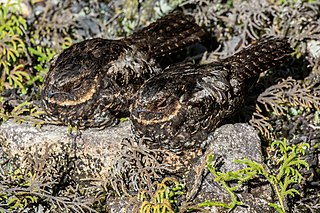
The Satanic nightjar, also Heinrich's nightjar, satanic eared-nightjar, Sulawesi eared-nightjar or diabolical nightjar is a mid-sized, spotted, dark brown nightjar endemic to the Indonesian island of Sulawesi. The species was discovered in 1931 by Gerd Heinrich, a German natural historian who collected a single female holotype from Mount Klabat on the Minahasa peninsula of Northern Sulawesi.
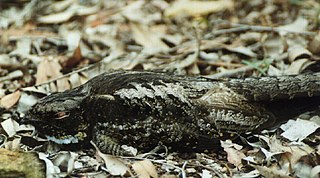
The eared nightjars are a small group of nocturnal birds in the nightjar family, although the taxonomy is uncertain. There are seven species, mainly found in forest and scrub from China to Australia. Five species are placed in the genus Eurostopodus, the other two species in Lyncornis. They are long winged birds with plumage patterned with grey and brown to camouflage them when resting on the ground. They feed on insects caught in flight. A single white egg is laid directly on the ground and incubated by both adults. The chicks can walk soon after hatching.

The Long-tailed Nightjar is one of 98 species of nightjar in the family Caprimulgidae, the "true nightjars". It is a nocturnal, insectivorous bird characterized by its distinctive long tail. It is found throughout mainland Africa in open areas, arid semi-deserts, and savannas, with common sightings alongside roadways.
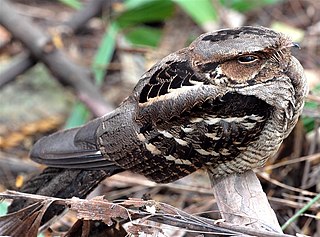
The large-tailed nightjar is a species of nightjar known for its distinctive long, broad tail and cryptic plumage that allows it to blend into its surroundings. Found along the southern Himalayan foothills, eastern South Asia, Southeast Asia and northern Australia, its natural habitats are subtropical or tropical moist lowland forest, subtropical or tropical mangrove forest, and subtropical or tropical moist montane forest.
Archbold's nightjar, also known as the mountain eared-nightjar or cloud-forest nightjar, is a species of nightjar in the family Caprimulgidae. It is found in the highlands of New Guinea. Its natural habitat is subtropical or tropical moist montane forests. It is named after American explorer Richard Archbold.

The spotted nightjar or spotted eared-nightjar is a species of nightjar in the family Caprimulgidae. It inhabits much of mainland Australia and has also been found in several Indonesian islands. Its natural habitats are open forests and woodlands, scrub, spinifex and tussock grassland, savannah woodland and mangroves.

The great eared nightjar is a species of nightjar in the family Caprimulgidae. It is found in southwest India and in parts of Southeast Asia. This very large nightjar has long barred wings, a barred tail and long ear-tufts which are often recumbent. It has a white throat band but has no white on its wings or on its tail.

The white-throated nightjar or white-throated eared-nightjar is a species of nightjar in the family Caprimulgidae. It is endemic to eastern Australia; it is a non-breeding winter visitor in Papua New Guinea. Its natural habitat is subtropical or tropical dry forests.
The Papuan nightjar or Papuan eared-nightjar is a species of nightjar in the family Caprimulgidae. It is found in New Guinea. Its natural habitats are subtropical or tropical moist lowland forests and subtropical or tropical mangrove forests.
The Malaysian eared nightjar or Malay eared nightjar is a species of nightjar in the family Caprimulgidae. They were previously known as Eurostopodus temminckii prior to their taxonomic revision. They are also known as Taptibau Kecil in Bahasa melayu or Tukang Tabtibau amongst Malaysian indigenous communities. They are dispersed throughout Southeast Asia, primarily occurring in Malaysia, Sumatra, Borneo, Thailand, Indonesia and Singapore. They are nocturnal insectivorous birds characterised by cryptic colouration of brown and white patterns, to aid them in camouflaging into their environment. Due to their nocturnal nature and feeding habits, they prefer subtropical, tropical and moist lowland forests, and have been recorded from sea-level to 1065 meters. They are easily distinguished by their 'ear-tufts,' giving them an "eared" appearance which led to their name.

The barred owlet-nightjar is a species of bird in the owlet-nightjar family Aegothelidae. It is found in New Guinea. The species was originally thought to be the same species as the Australian owlet-nightjar, until that species was found within the range of the barred owlet-nightjar. It was also considered to be the same species as the Vogelkop owlet-nightjar. There are three subspecies, the nominate, from south-eastern New Guinea, A. b. wiedenfeldi from northern New Guinea, and A. b. plumifer from the D’Entrecasteaux Islands.
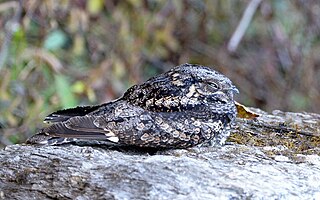
The grey nightjar is a species of nightjar found in East Asia, breeding from southeastern Russia south through China, the Korean Peninsula and Japan to northern Indochina and westward along the Himalayas. It is largely migratory, wintering in Indochina south to Java in Indonesia, but is resident in warmer areas in the south of its breeding range. It is sometimes treated as a subspecies of the jungle nightjar, its South Asian relative. The grey nightjar breeds and forages in early successional habitats surrounded by forests; its populations have declined since the 1970s in Japan. Like all nightjars, it is crepuscular to nocturnal, feeding on flying insects, including moths, beetles, flying ants, grasshoppers, and others.

Shendurney Wildlife Sanctuary is a protected area in the Western Ghats, India, located in Kollam district of Kerala and comes under the control of the Agasthyamalai Biosphere Reserve. It was established on 25 August 1984 and comprises 172.403 square kilometres (66.565 sq mi). The name is a corruption of the Chengurinji, a tree endemic to the region. Tropical evergreen and semi-evergreen forest cover a major area of the sanctuary. The sanctuary has an artificial lake of nearly 18.69Sq.km size and also surrounded by the reservoir of Thenmala Dam. The Shendurney Wildlife Sanctuary is a treasure house of plant diversity. About 1257 species of flowering plants belonging to more than 150 families are reported from this sanctuary of which 309 species are endemic to Western Ghats. Birds from 267 species including migratory, endemic and endangered species have been reported here. It has a presence of lion-tailed macaque, a highly endangered species.

Lyncornis is a genus of eared nightjar in the family Caprimulgidae.
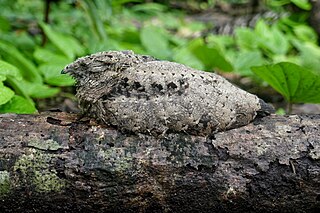
The Solomons nightjar is a species of nightjar in the family Caprimulgidae. It is found in the Solomon Islands archipelago. Its natural habitat is subtropical or tropical dry forests. It avoids human activity, and is nocturnal.














